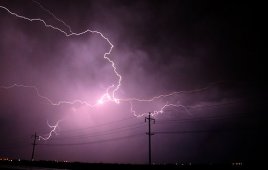Bringing a wind project to fruition is a multi-phased process. Financing and approvals are understandably foremost on developers’ minds, while risk management and loss prevention rarely top their “to do” lists. Yet every phase of the project: from planning, through to construction, maintenance, and ultimately disposal, poses risks that deserve thorough consideration. An effective risk management plan can ensure that developers are prepared to deal with setbacks quickly and efficiently. Conversely, a lack of preparation can significantly delay or halt operations, which can mean business losses upwards of $100,000 a day.
Although each project is different, an experienced insurer can help project managers tailor loss prevention to their particular needs. The following are some of the often overlooked risk factors that partners should consider when developing a wind project.
Location. Location. Location.
Is the project in a natural catastrophe zone or offshore? It’s important to pay close attention to the particulars of a project’s natural setting. For example, Canada’s Northwest Territories present different risks than a European offshore wind project. Varying with the wind farm’s geographic location, site preparation can be highly complex, often more so than developers (without a thorough risk analysis) anticipate. These aspects can include constructing access roads for transporting parts, clearing areas for turbines, preparating foundations with excavation and form-works, and even special lift arrangements. Each presents its own potential risks that could stall the project’s completion and prove unsettling for investors and customers.
Transportation
Getting equipment to the site, whether by sea or land, can present major perils. Massive turbine parts can be a significant burden for transport ships, trailers, and routes. This creates a significant risk for damage or loss en route to the site.
For example, a wind-turbine load can shift on a ship damaging the blades. Losing a deck-transported tower section overboard is also not unheard of. It’s important to consider who is responsible for transportation and what will be done if a delay occurs. Does the manufacturer’s policy provide coverage for delays?
Once on land, potential pitfalls include landslides, access roads collapsing from equipment weight, trucks mired in soft soil, or an overturned trailer. Ensuring a proper turning radius becomes a mission-critical consideration.
Supply and maintenance
Once components have arrived on site, a host of additional issues can arise. A good insurance partner can identify potential pitfalls so you can plan ahead. For example, there is a limited supply of contractors’ equipment that meets the needs of the wind sector within North America and around the world. A well thought out site delivery plan, including contingencies for unavailable equipment, is imperative to avoid costly delays during construction and operation. Create a plan to secure proper equipment for installation. Developers need to establish a well-defined relationship with reliable, experienced contractors with access to the right equipment. It is equally vital to know which manufacturers have replacement parts available and how quickly they will arrive.
Of course, many wind-project owners purchase business-interruption insurance that carries a project for a defined period. But it is almost always preferable to be back up and running as soon as possible. Operational business interruption coverage and delayed startup (DSU) coverage is available for construction. It’s a good idea to have a preventative plan in place that includes regular maintenance (under warranty cover) and stocking or ensuring ready access to spare parts that tend to break more often. Ignore these steps and it may take up to two years to procure a full replacement.
These risk factors are by no means exhaustive with unique projects, a dynamic industry, and evolving technology. What’s important is to plan for risk factors that can impact each phase of a wind farm’s life cycle. Working with an experienced insurance partner can help save valuable resources. WPE
 By: Rob Cruickshank, Director, Construction and Renewable Energy at RSA Canada www.rsagroup.ca
By: Rob Cruickshank, Director, Construction and Renewable Energy at RSA Canada www.rsagroup.ca
Filed Under: Insurance




